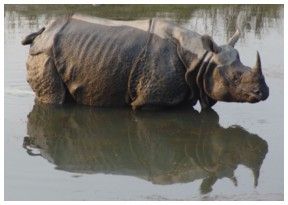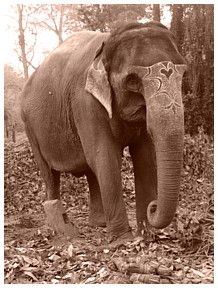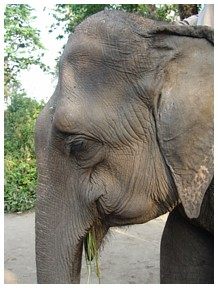|
The "Royal Chitwan National
Park" is situated in the south of Nepal, on the
Terai planes, which is on the Northern border of
India, and is so flat
because of the presence of the enormous river Ganges. "Chit" means heart
and "wan" means woods, or jungle, the same as the
Bangladeshi word "ban"
in
Bandarban and
Sundarban. It is a vast protected area, without any roads, and just a
few basic resorts, most of them without electricity. Shower between
6 and 7, read and eat between 6 and 9; and get up at 5.30 AM (ouch). Many animals live there, like crocodiles,
tigers, rhinos, deer, and of course elephants to transport the tourists.We
did not see any tigers, but we saw a crocodile, some deer and many rhinos,
even from up close. Contrary to what they may look like, they move very
graciously.
 We even met a couple of them, who were clearly in the process
of getting acquainted. The drivers of the elephants formed a circle around
them and made us close them in. I did not feel very good about that, most
probably because my imagination showed me a circle of rhinos, closing in
on my bed at night. We even met a couple of them, who were clearly in the process
of getting acquainted. The drivers of the elephants formed a circle around
them and made us close them in. I did not feel very good about that, most
probably because my imagination showed me a circle of rhinos, closing in
on my bed at night.
The rhinos like to
bath, but so do the elephants. Bathing the elephants is a regular part of
the tourist menu in the safari park. Those tourists who like such an
activity, can bathe themselves and the elephants in the river. The best
part of the program is, where the tourist climbs the elephant when it is
kneeled in the water, it stands up, takes a lot of water in its trunk and
showers the tourist. Our
Anna also enjoyed that and wanted to
participate. The elephant however was much quicker than she expected, and
she already gets a big shower before it even stood on its legs. She cried
as many tears as the elephant showered water and we had to rescue her
immediately. There was no time left for a picture, but the other kids did
better on that, luckily.
   After
the bath, one of the elephants is painted beautifully
and that restores Anna's trust in them. She climbs this animal and after
ten minutes or so, she is asleep on the uncomfortable wooden bench on it's
back. After
the bath, one of the elephants is painted beautifully
and that restores Anna's trust in them. She climbs this animal and after
ten minutes or so, she is asleep on the uncomfortable wooden bench on it's
back.
Between 1850 and 1948, Nepal was not open to tourists. Therefore, the only
people who came to this place then, were kings and viceroys and their
families. They normally came for hunting, but as their number was so
limited, it was not even a major problem when one of the visiting viceroys
shot one hundred rhinos in one visit, because in those days, there were
far more animals then foreigners. Luckily, the tourists are no longer
allowed to kill the animals, because the tables have turned nowadays. And
still, rhinos get killed. and are even threatened with extinction.
Smugglers kill them and transport the dead animals across the border to
India and China. The meat is not of any value, but the horns are ground to
powder and sold as a miracle solution against baldness and as aphrodisiac.
The rhinos themselves are practically bald and donít look very sensual, so
the chance of success is zero. Therefore, it is even sadder, that people
kill them for this reason. |